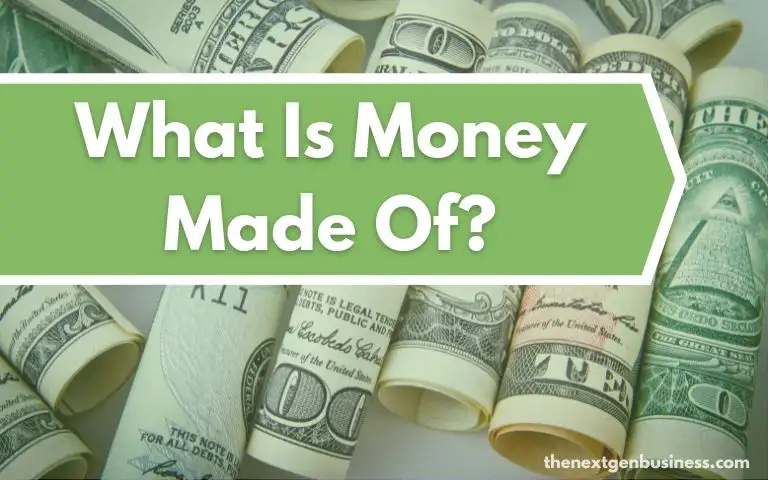
Have you ever gone to pay for something in cash and wondered what money is made of? Well, you wouldn’t be alone.
Every day, we transact with our countries’ currency and most don’t know the actual ingredients used to create money.
In the United States, American paper currency is the country’s main form of money. The dollar is made out of 75% cotton and 25% linen. The people responsible for creating this money are the Bureau of Engraving and Printing, sometimes referred to as the BEP.
Although, the U.S. is not the only country with physical money. Below, you’ll find the exact ingredients used to create money in different countries around the world!
What Money Is Made of In Different Countries (In 2022)
The United States is one of the more popular countries which use physical money for transactions. However, there are plenty of other countries that transact with physical money as well.
United States
Currency: USD
Made Out Of: 75% cotton and 25% linen
United States Dollar First Introduced In: April 2, 1792
Symbol: $
United States Banknotes: $1, $5, $10, $20, $50, $100
Canada
Currency: CAD
Made Out Of: Synthetic Polymer
Canadian Dollar First Introduced In: 1934
Symbol: $ or C$
Canada Banknotes: CAD $5, CAD $10, CAD $20, CAD $50
Italy
Currency: EUR
Made Out Of: Cotton Fiber
Euro First Introduced In: January 1, 2002
Symbol: €
Italy Banknotes: €5, €10, €20, €50, €100, €200, €500
Ireland
Currency: EUR
Made Out Of: Cotton Fiber
Euro First Introduced In: 2002
Symbol: €
Ireland Banknotes: €5, €10, €20, €50, €100, €200, €500
Australia
Currency: AUD
Made Out Of: Polymer
Australian Dollar First Introduced In: February 14, 1966
Symbol: $ or A$
Australia Banknotes: Australian five-dollar note, Australian ten-dollar note, Australian twenty-dollar note, Australian fifty-dollar note, Australian one-hundred-dollar note
Sweden
Currency: SEK
Made Out Of: Cotton Fiber
Swedish Krona First Introduced In: 1873
Symbol: kr
Sweden Banknotes: 20 kr, 50 kr, 100 kr, 200 kr, 500 kr
United Kingdom
Currency: GBP
Made Out Of: Polymer
Pound Sterling First Introduced In: 1694
Symbol: £
United Kingdom Banknotes: £5, £10, £20, £50
Iceland
Currency: ISK
Made Out Of: Reinforced Paper
Icelandic Króna First Introduced In: 1981
Symbol: kr or Íkr
Iceland Banknotes: 500 krónur, 1000 krónur, 2000 krónur, 5000 krónur, 10000 krónur
Norway
Currency: NOK
Made Out Of: Cotton Paper
Norwegian Krone First Introduced In: 1875
Symbol: kr
Norway Banknotes: 50 kr, 100 kr, 200 kr, 500 kr, 1000 kr
Japan
Currency: JPY
Made Out Of: Mitsumata, abaca pulp, and a few different other fibers.
Japanese Yen First Introduced In: 1869
Symbol: ¥
Japan Banknotes: ¥1, ¥5, ¥10, ¥50, ¥100, ¥500
France
Currency: EUR
Made Out Of: Cotton Fiber
Euro First Introduced In: January 1, 2002
Symbol: €
France Banknotes: €5, €10, €20, €50, €100, €200, €500
Denmark
Currency: DKK
Made Out Of: Not Specified
Danish Krone First Introduced In: 1875
Symbol: Kr.
Denmark Banknotes: 50 kroner, 100 kroner, 200 kroner, 500 kroner, and 1000 kroner
Jamaica
Currency: JMD
Made Out Of: Polymer substrate
Jamaican Dollar First Introduced In: 1969
Symbol: $ or J$
Jamaica Banknotes: $50, $100, $500, $1000 and $5000
Germany
Currency: EUR
Made Out Of: Cotton Fiber
Germany First Introduced In: January 1, 2002
Symbol: €
Germany Banknotes: €5, €10, €20, €50, €100, €200, €500
Mexico
Currency: MXN
Made Out Of: 20 peso and 50 peso made out of polymer, 100, 200, 500, and 1000 pesos made out of cotton paper.
Mexican Peso First Introduced In: 1821
Symbol: $ or Mex$
Mexico Banknotes: 20 peso, 50 peso, 100 peso, 200 peso, 500 peso, and 1000 peso
South Korea
Currency: KRW
Made Out Of: Not Specified
South Korean Won First Introduced In: 1950
Symbol: ₩
South Korea Banknotes: ₩1,000, ₩5,000, ₩10,000, ₩50,000
Brazil
Currency: BRL
Made Out Of: Paper
Brazilian Real First Introduced In: 1994
Symbol: R$
Brazil Banknotes: R$2, R$5, R$10, R$20, R$50, R$100, R$200
Israel
Currency: Israeli new shekel
Made Out Of: Some made of paper and some polymer.
Israeli New Shekel First Introduced In: 1986
Symbol: ₪
Israel Banknotes: ₪20, ₪50, ₪100, ₪200
Thailand
Currency: THB
Made Out Of: Cotton Fiber
Thai Baht First Introduced In: 1902
Symbol: ฿
Thailand Banknotes: ฿20, ฿50, ฿100, ฿500, ฿1000
Egypt
Currency: EGP
Made Out Of: Polymer
Egyptian Pound First Introduced In: 1899
Symbol: E£ or ج.م
Egypt Banknotes: 1, 5, 10, 20, 50, 100 and 200 Egyptian pounds
Philippines
Currency: PHP
Made Out Of: 80% cotton and 20% abaca
Philippine Peso First Introduced In: 1967
Symbol: ₱
Philippines Banknotes: ₱20, ₱50, ₱100, ₱200, ₱500, and ₱1000
India
Currency: INR
Made Out Of: Cotton
Indian Rupee First Introduced In: 1947
Symbol: ₹
India Banknotes: ₹10, ₹20, ₹50, ₹100 ₹200, ₹500, and ₹2000
Is Money Made From Trees?
No, money is not made from trees. In the United States, the dollar is actually made up of 75% cotton and 25% linen. No trees were used to create American dollars.





